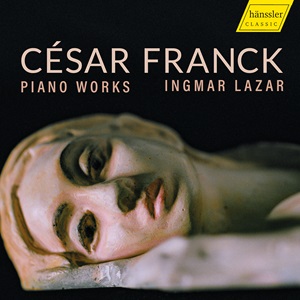
César Franck (1822-1890)
Piano Sonata No 1 (1835-36)
Grand Caprice (1843)
Prélude, Aria et Finale (1886-87)
Prélude, Choral et Fugue (1884)
Ingmar Lazar (piano)
rec. 2023 at Studios Berdugo, Croissy-sur-Seine
Hänssler Classic HC22055 [73]
Some piano rarities were unearthed in Franck’s bicentenary year 2022 – I had not heard his transcription of part of his oratorio Ruth or his variations for piano and orchestra prior to that. French pianist Ingmar Lazar now brings us the first Piano Sonata, the Première Grande Sonate Op 10, written when Franck was just thirteen. It is among a group of juvenilia that, except for the Première Grande Caprice Op 5, Franck all but disowned as music belonging to his early years both as a student and touring virtuoso. It has been recorded previously by Patrick Dheur on Stradivarius STR37222 but in a trimmed version; all the tremolos in the introduction are cut, the second movement loses its first seven and final fourteen bars and there are numerous cuts in the finale. Lazar plays the whole sonata without cuts and does so very well, though for all its charms it is nonetheless a very derivative piece; after the introduction with its low tremolandos and hymn like chords there is a Mozartian allegro with some energetic finger work that is reminiscent of Hummel and his contemporaries. The second movement features a simple melody over a quaver accompaniment, though once again it is prefaced by a dramatic introduction. This gives some balance to the movement that ends with a grand statement of the theme and a concluding cadenza. It is a little much for a short adagio, perhaps why Dheur cut so much. The concluding rondo finale is humorous and virtuosic, engaging enough to excuse some rather awkward phrase lengths. Lazar’s tempo is not quite as fast as Dheur’s but is all the more rhythmic and full of character for that. I was going to say it is not that memorable a work, but the rondo theme has been an earworm for the last two weeks, so perhaps I am mistaken. More memorable and effective is the Grand Caprice from Franck’s early twenties, a flashy extrovert piece that would have suited the young virtuoso down to the ground. The opening cadenza is a real attention grabber, though Franck chooses a quieter theme to continue proceedings – not without another brief cadenza to dazzle here and there. This theme appears throughout the piece with varying degrees of decoration - syncopation and triplets, then left-hand octaves and finally an extravagantly virtuosic version in repeated chords to bring the piece to an end. Along the way there are two more themes, one jaunty and bright, the other dramatic and urgent with its relentless left-hand semiquavers. If a wee bit overblown at times it is a perfect example of the spirit of early 19th century pianism and Lazar revels in it, completely attuned to its rhetoric and energy.
Apart from the tiny Les plaints d’une poupée Franck wrote nothing more for the piano for four decades; the two mature works recorded here and the danse lente represent his entire output for solo piano in his final six years. He had not been idle in the intervening period, composing many sacred choral works and a large volume of music for the organ in his capacity as organist at Saint-Jean-Saint-François church and this shows in his later piano writing. The intricate, multi-layered textures are organ-like in their layout, a far cry from his earlier writing, though the dramatic central section of the Grand Caprice hints at what’s to come. With more meat to get hold of, Lazar is even more impressive, commanding a wide range of dynamics and colour. He is careful to avoid rigorous playing. In the toccata like sections of the finale of the Prélude, Aria et Finale he has plenty of space to shape the melodic fragments and inner voices without compromising on the allegro molto de agitato marking. In quieter moments his control of texture and line brings a clear distinction between Franck’s carefully notated non troppo dolce and più dolce and he floats the opening melody of the Prélude, Choral et Fugue beautifully. The fugue here is monumental with a rich piano sound, great clarity in the appearances of the fugue subject and glorious balance of voicings within chords and in incorporating the prélude’s theme into the fugue.
With tutors including Vladimir Krainev, Malcolm Bilson, Fou Ts’ong and Elisso Virsaladze, Lazar has an excellent pedigree and on the strength of this CD, particularly the mature works, he is a name I’ll be looking out for.
Rob Challinor
Help us financially by purchasing from




















